| In the United States, ticks are responsible for more human disease than any other insect. They are very good at this because they feed on a large variety of mammals, reptiles, and even birds. Six different tick-borne diseases have been reported in Missouri. They are Rocky Mountain spotted fever, Lyme disease/Lyme-like disease, tularemia, Q-fever, erlichiosis, and southern tick associated rash illness. The mysterious Heartland virus is also thought to be spread by ticks. Confirmed cases of tick-borne illness must be reported to the Centers for Disease Control.
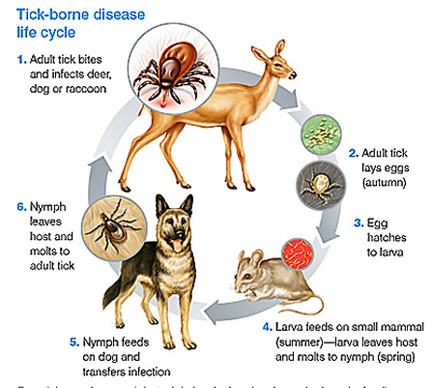
How ticks spread disease
Depending on the species of tick and its life stage, preparing to feed can take anywhere from 10 minutes to two hours. When a tick finds the perfect feeding spot, it grasps the skin and cuts the surface. Next, it inserts its feeding tube. If that sounds painful, well, it isn't because most ticks secrete a small amount of saliva that has anesthetic properties. So, the tick can attach without the person or animal feeling it. A tick will suck the hosts blood slowly over several days. During that time, it can either receive or transmit diseases. In most cases, the tick must be attached for 36 to 48 hours to transmit bacteria.
Preventing tick bites
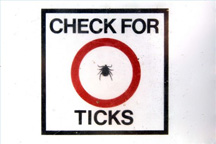
Obviously, avoiding contact with a tick means avoiding its habitat. One ups the odds for exposure by wandering into wooded or bushy areas with high grass or leaf litter and straying off of an established path when hiking. Using a repellant with at least 20 percent DEET is recommended. After being in an area where ticks are prevalent--or even, perhaps, just being in a grassy area like your backyard, carefully do a body check on those possibly exposed, including pets. Check your gear and your clothing that you might put in the dryer for at least an hour to kill any ticks you could have missed seeing.
Oh no, I have a tick on me! (How to remove a tick)
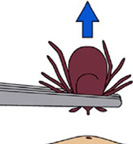
First of all, dont panic! Use a fine tipped tweezers to grasp the tick as close to the skins surface as possible. Pull upward, with steady, even pressure
(Do not twist or jerk, because that can cause the ticks mouth parts to break off in the skin. If that happens and the mouth cannot be removed easily, leave it and let the skin heal.) Thoroughly clean the area with rubbing alcohol or soap and water.
Avoid folklore remedies such as painting ticks with nail polish or petroleum jelly. The goal is to remove the tick as fast as possible and not wait for it to fall off.
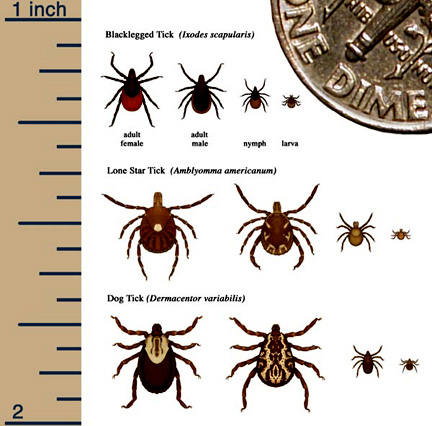
Various diseases, the ticks that spread them, who is most at risk, what symptoms should one look for and what is the preferred treatment include:
- Rocky Mountain spotted fever (RMSF) is caused by the organism Rickettsia parkeri carried by the Rocky Mountain wood tick, the American dog tick and the brown dog tick. Incidence of the disease is highest in American Indian males over the age of 40. The name for this disease, the most lethal and frequently reported infection in the U.S., is a misnomer, because even as far back as the 1930s, it was clear that the disease was not confined to the Rocky Mountain area. The highest incidence of cases is found in Missouri, Arkansas, Oklahoma, Tennessee, Delaware, and North Carolina. Classic symptoms include: fever and rash, as well as more severe symptoms of nausea and vomiting, severe headache, muscle pain and loss of appetite. The characteristic rash that only occurs in 35 to 60% of sufferers begins as small, pink, non-itchy spots, which appear first on the ankles and wrists. Later, the rash becomes more spotted and can appear on the trunk, palms, and soles. Delays in treatment can lead to death! Other complications include: encephalitis, pulmonary edema, adult respiratory distress syndrome, arrhythmia, impaired blood clotting, GI bleed, skin necrosis, paralysis, hearing loss, loss of bowel and bladder control. For treatment the drug of choice is doxycycline.
- Lyme disease is caused by the organism Borellia burghorferi (a spirochete) carried by black legged deer ticks. Lyme disease was named in the late 1970s, when physicians observed arthritis in a group of children living in Lyme, Connecticut. The actual cause of the disease was first identified in 1982. Since then, there have been more than 150,000 reported cases of Lyme disease.
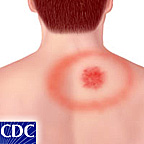
Symptoms that were noted include in early stages: a bulls-eye rash, swelling of lymph glands near the tick bite, generalized achiness and headache. Early disseminated symptoms are a rash (away from the site of the bite), migrating pains to joints and tendons, stiff neck, facial paralysis, tingling or numbness of extremities, abnormal pulse, sore throat, changes in vision, fever, and severe fatigue while late stage symptoms are arthritis, disorientation, dizziness, short term memory loss and inability to concentrate. For an early infection the drug of choice is doxycycline which should not be given to pregnant women or children under the age of 8 because it can cause permanent tooth discoloration later in life. Late infection may require IV ceftriaxone. From late 1998 through early 2002, there was a vaccination for Lyme disease. However, GSK stopped manufacturing the antibiotic due to a lack of consumer demand and relative ineffectiveness. Also, lawsuits claiming that the vaccine caused autoimmune damage probably did not help sales.
- Ehrlichiosis is caused by the organism Ehrlichia chatteenis or rickettsia and it is carried by the Lone Star tick, deer tick and American dog tick. The disease is prevalent in males over the age of 50, especially those living in Missouri, Oklahoma and Tennessee. Symptoms include fever, headache, tiredness, muscle pains, chills, nausea and voting, confusion, and joint pain. A rash may appear in 60% of children but less than 30% of adults and it is usually not at the site of the tick bite. Complications might include coma, kidney and lung damage and seizures. For treatment doxycycline again is the drug of choice, although rifampin may be used in children and pregnant or breast feeding women.
- Heartland virus is the least understood. As to origin recent studies point to the Lone star tick as a possible disease spreader. As of March 2014, there have been eight reported cases in Missouri and Tennessee. All of the cases were in men over the age of 50, who reported exposure to ticks before becoming ill. Symptoms include: fever, fatigue, anorexia, nausea, and diarrhea. There is no specific treatment.
This article was compiled by Ashley Taylor, Pharm.d., Meyer Orthopedic & Rehabilitation Hospital Pharmacy/CoxHealth, Springfield, MO. For more information contact the websites of the U.S. Centers for Disease Control and Prevention and the Missouri Dept. of Health and Senior Services.
Go Back |







